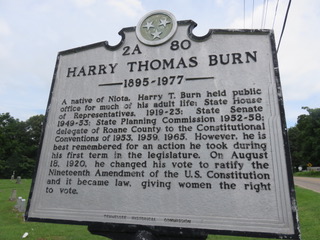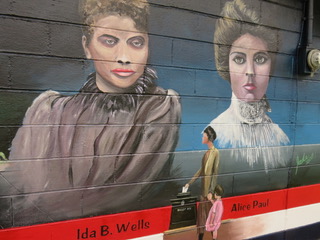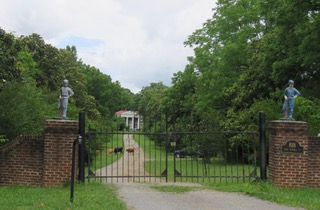
Grave marker of parents Jim and Febb Burn
photo by John Shearer

Harry and Ellen Burn’s graves
photo by John Shearer

Harry Burn’s grave marker
photo by John Shearer

Several Burn graves lined up in a row
photo by John Shearer

Grave of McCallie grad Harry Burn Jr.
photo by John Shearer

State historical marker to Harry Burn
photo by John Shearer

Old Crescent Sock mill building
photo by John Shearer

Niota United Methodist Church
photo by John Shearer

Niota train station and town marker
photo by John Shearer

Backside of Niota Depot
photo by John Shearer

Northwest corner of Niota Depot
photo by John Shearer

Red caboose by depot/City Hall
photo by John Shearer

The southwest corner of depot
photo by John Shearer

Mid-century Niota post office
photo by John Shearer

Full suffrage mural
photo by John Shearer

Harry Burn on mural with mother’s letter
photo by John Shearer

Part of suffrage mural
photo by John Shearer

Ida Wells and Alice Paul on mural
photo by John Shearer

Site of Harry Burn’s razed childhood home
photo by John Shearer

Entrance gate to former Harry Burn home
photo by John Shearer

Former Harry Burn home, Hathburn
photo by John Shearer
As Tennessee celebrates the centennial this year of its proud role in giving women the right to vote by being the final and deciding state to ratify the 19th Amendment, I decided to head to Niota, Tn.
Niota is located a short distance off exits 52 and 56 on Interstate 75 a little less than an hour’s drive from Chattanooga.
But I do not believe I had actually ever been there before, and maybe many other Chattanoogans have not, either.
And why was I going to Niota, the small town in McMinn County, for my sixth and final story in this series? I went there because Niota was the hometown of a 24-year-old state legislator named Harry Burn. Most credit him with helping break the tie in a close state House vote to approve the amendment after many were not sure how he was going to vote or thought he would vote against ratification.
And as was only fitting for this amendment that greatly changed the role of women, he did it in an all-male state House, but with the influence of a woman – his mother, Febb Burn. While not a marcher or overly outward advocate for the suffrage movement, her experiences running a farm with male workers and eligible voters under her made her realize the American voting system needed to be fixed.
So, since she had not seen anything in the papers about how her son was going to vote, she sent him a multi-faceted letter to Nashville that in part encouraged him to support ratification.
He did, and the House had just enough votes to approve ratification on Aug. 18, 1920, after the state Senate a few days earlier had overwhelmingly supported the measure.
It was a monumental victory, since American women had first begun formally pushing for the right to vote since the mid-1800s. In fact, some have called it the greatest example of perseverance for a seemingly just cause in American history – at least regarding a tangible goal.
As a result, some could argue Niota was the second most important community behind Nashville for what took place during those few days in 1920 after Gov. Albert Roberts had heeded President and fellow Democrat – and suffrage supporter -- Woodrow Wilson’s call for the special session.
Today, Niota is a very quiet community to an outsider, in part because it sits just far enough off the Interstate. It is not hard for one to imagine what it must have been like here in 1920 when the vote was taking place.
And I found it a pretty town worth visiting. That is not only because of the sights related to the 19th Amendment, but also due to the rural places that don’t have zoning or for-sale signs in front of them, as many places on the outskirts of Chattanooga do. The scenes of old barns, pastureland and cattle are refreshing here. I even found some cows in front of a stately old home once belonging to the Burn family!
While some people interested in Harry Burn and the 19th Amendment have found their way to see his grave and maybe the nearby state marker in easily accessible locations, I was aided with the help of Tyler Boyd to see additional sites.
Mr. Boyd is a schoolteacher and great-grandnephew of Harry Burn on his mother’s side and has recently written a book about his famous relative called “Tennessee Statesman: Harry Burn” in connection with the centennial anniversary.
In the book, he points out what he says have been some misconceptions and legends about Harry Burn and the vote.
First of all, he points out that Mr. Burn did not change his votes from previous votes when the decisive one was taken. The previous votes were to table the measure, in part to give counties time to hold Constitutional conventions to see where constituents stood.
Mr. Burn had also stated he was going to vote against ratification because that is what he thought most of his constituents in McMinn County wanted. He was personally for the amendment, according to Mr. Boyd’s book, and was planning to vote for it if the vote seemed close. That factor and the letter that arrived from his mother that morning made him vote “aye,” which, along with state speaker Seth Walker’s surprising vote, gave it a 50-46 approval.
Mr. Walker, who was against it, said he voted aye so he could bring it back up for discussion further, although that never took place.
There were also rumors Mr. Burn had been bribed, but that was quickly discounted after the vote.
Mr. Boyd also points out what actually happened to Mr. Burn after the vote in the chaotic House chamber and around the capitol, when some thought he would be either overrun with congratulations or harassment, especially the latter.
Not wanting any of that or to be under any special protection of any sergeants at arms, he slipped into a room, climbed out on a dangerously narrow ledge and walked to a portico. He then went into the old State Library, Mr. Boyd explained in his book, and climbed the stairway to the upper area for about 15 or 20 minutes.
He then went outside to the Carmack Statue – which has been in the news in 2020 due to protests over statues of people with uncomplimentary pasts. Some sergeants at arms saw him, but he took off running to the Hermitage Hotel, where he put on some glasses and pulled down the brim of his hat to be unrecognizable after he had lost the pursuers.
He then went to the law office of a female friend and suffrage supporter, and after a time there, she drove him to Shelby Park three miles east of Nashville. By the time they returned, the situation had cooled.
However, an angry Louisiana woman who was against the amendment showed up at his mother’s Niota house the next day, as did some media.
With all this history and the anniversary approaching, I was looking forward to my trip to Niota. In some email correspondence with Mr. Boyd, he had kindly outlined places to go to visit in Niota related to the Burn family and the 19th Amendment.
The first place I stopped after exiting Interstate 75 at Exit 56 and getting on U.S. 11 after being in Knoxville was the Niota Cemetery and the state historical marker to him. As Mr. Boyd pointed out, the cemetery is at the only traffic light in town, making finding it easy even for those who are directionally challenged or without wanting to use a GPS navigation system.
Harry Burn’s grave is easy to find as well, as it is in the middle of the cemetery – although one does have to work through the several other Burn family members buried there to see it. Mr. Burn, who lived until 1977, is buried by a somewhat modest marker, as is his wife, the little-discussed Ellen Folsom Cottrell, who actually lived until 1998.
After previously having so much trouble finding the Greenwood Cemetery grave of a Chattanooga legislator involved in the 1920 vote, as I documented in the previous story in this series, this was a pleasant surprise.
At Niota Cemetery, the most impressive marker is that to his parents, James and Febb Burn, and sister, Sara, who died as a child. His father, who worked for the railroad, had died of typhoid fever in 1916, so he did not live to see his son’s unusual moment of fame.
One row north of these two generations of Burns is the grave of Harry T. Burn Jr., an only child, who went on to graduate from McCallie School in 1955. He was born in 1937, nearly two decades after the ratification of the 19th Amendment, and he died in 2016 – 100 years after his grandfather.
The state historical marker located on the edge of the cemetery along the highway talks about the elder Harry Burn’s life, including his time as a state senator from 1949-53 -- decades after his four years in the state House -- and, of course, his role in the ratification vote.
I then got back on Highway 11/Willson Street to try and find some of the other places of interest Mr. Boyd had mentioned. I had passed the Crescent Sock Company on the left on the way to the cemetery, so I went a short distance back north. Harry Burn’s father had co-founded this business as Crescent Hosiery Mill in 1902, and I quickly realized the only part of the complex that would have dated back that far was a smaller red-brick building a little behind and to the side of the main facility, so I took a picture of it.
Mr. Boyd said his mother, Sandra Burn Boyd, and two of his aunts now own and operate it. They are Febb’s great-granddaughters, and Febb’s fainting couch is in the front lobby.
“I think it’s great that Harry T. Burn’s great-nieces own and operate a business in his hometown when 100 years ago women could not even vote, much less own or manage a business,” Mr. Boyd said in his correspondence.
I then got back on Highway 11 and headed south, not realizing all but one of the places he mentioned were within 200-300 yards or so of each other. After going a mile or so down the road, I realized I was definitely out of Niota proper. So, I turned around and headed back and soon found Main Street, which runs basically parallel to Highway 11 on the east side.
The first place I saw going back north was the historic Niota United Methodist Church, by far the prettiest building I saw on my tour. It is closely connected to Febb Burn, the woman who was able to close the deal on the 19th Amendment in an unusual way.
As Mr. Boyd explained, “Febb Ensminger Burn was raised a Methodist in Athens. Although she attended First Baptist Church of Niota with her husband, I don't believe she ever joined. Once he passed away, she began attending the Methodist church.
“Her funeral was at the Methodist Church. Also, she and her husband Jim donated money to the Methodist church.”
I then went 100 yards or so north on the not completely straight Main Street, and in the area behind the First Baptist Church complex near the corner of Burn Road was the site of the former home where Harry Burn was born and raised. It had been demolished in the 1970s, Mr. Boyd said.
Continuing north on Main Street about 100 yards or so – past the interesting mid-century style Niota post office on the left – I next visited the Niota Depot. While not quite as eye-catching as some small-town railroad depots – like the one in the fellow McMinn County community of Etowah – it is very historic.
In fact, like Mr. Burn’s role in the suffrage amendment ratification, it plays a unique role in the history of the railroad in Tennessee.
“Built in 1854, it is the oldest standing rail depot in the state of Tennessee,” said Mr. Boyd. “It was occupied by both Union and Confederate forces during the Civil War. Gun ports are still visible on the inside where they knocked out some bricks.”
The building, where Harry Burn’s father, Jim, was the station master until his sudden death in 1916, now serves as the City Hall. It also has a Southern Railway caboose outside.
Harry Burn had also begun working for Southern Railway in the 1910s about the time he finished high school and served as a relief agent, telegraph machine operator, ticket salesman and baggage checker. And two of the stations where he was assigned were the ones in East Chattanooga and Ooltewah.
The Niota Depot building also has an interesting connection to Harry Burn and the famous 1920 state House ratification vote. “Febb’s famous letter to Harry traveled from a train that departed the depot bound for Nashville,” said Mr. Burn.
About 50-75 yards south and on the same side of the street as the Depot is the tiny, currently closed Niota Public Library. But on one side of it is the large Niota Suffrage Mural, which was unveiled in January to kick off the centennial year.
Done by artist Jade Lewis, it features scenes of Harry Burn with his famous letter, Febb Burn, early suffrage pioneer Susan B. Anthony and later suffrage advocates Ida B. Wells and Alice Paul. Ms. Wells had also been a pioneering black journalist, while Ms. Paul once spent some time in Britain and later in the U.S. went on a hunger strike along with some others, showing how serious some were about the suffrage movement. Other scenes are also depicted in the mural.
The colorful display does give some neat visualization to Niota’s brief-but-unique connection to the suffrage movement.
My final stop was at 818 E. Farrell St., at the home where Harry Burn and his family lived starting in 1914. Mr. Boyd said in his book that the family had wanted to live in a new place after the death of Harry’s sister, Sara, at a young age following a spinal injury, so Jim Burn bought at public auction this large, 11-room home a mile or two north of the downtown area.
Built in the 1840s, it sits a few yards off Farrell Street, but is visible from the road. The owner of the home is now Richard Rutledge, who I understand gladly gives tours, although I did not try to arrange one.
The home for a period was called Hathburn from the following capitalized letters in the famous legislator’s name: HArry THomas BURN.
It is a nice-looking estate – although in a small-town way, with cows along the entrance driveway – and the Burns were reportedly uncomfortable calling it a mansion over the years.
It also has some Union and Confederate soldier statues and ornamentation on the nice gate, apparently a nod to the fact Jim Burn’s ancestors fought for the Union and Febb Burn’s for the Confederacy in the Civil War.
Febb Burn’s father, Tom, had also fought for the Confederates at Chickamauga and became an invalid after he was hit in the back with a mini ball during the Battle of Missionary Ridge.
Civil War emblems have come back to the forefront in recent weeks in light of the George Floyd death and other accusations of police brutality, and so has the 19th Amendment due to its 100th anniversary.
But in contrast to the former, the issue of women’s suffrage has long since been brought to a peaceful and respectful conclusion. Virtually everyone now agrees that the right step was taken in giving women an equal voice at the ballot box.
And Tennessee can take great pride in standing proverbially tall by making this monumental moment happen and by giving the amendment the 75 percent approval needed at a time when 12 other states were apparently not willing to do that.
And as a strange twist, after thousands of women had pushed for it, and one wrote a very important letter at the end, the final step fell on a young man named Harry T. Burn.
You know, the one from Niota, Tn., where memories of him are still very much alive, even after a century!
* * * * *
To see the previous entry in this series, read here.
https://www.chattanoogan.com/2020/5/8/408764/John-Shearer-The-19th-Amendment.aspx
* * * * *
Jcshearer2@comcast.net